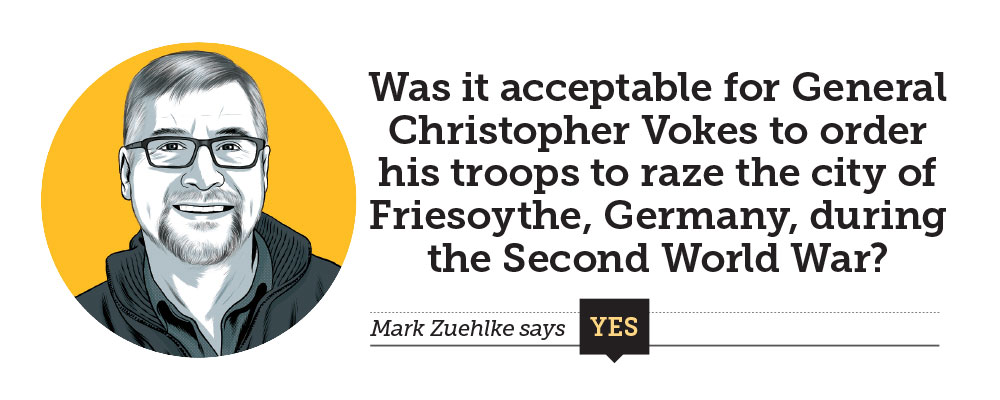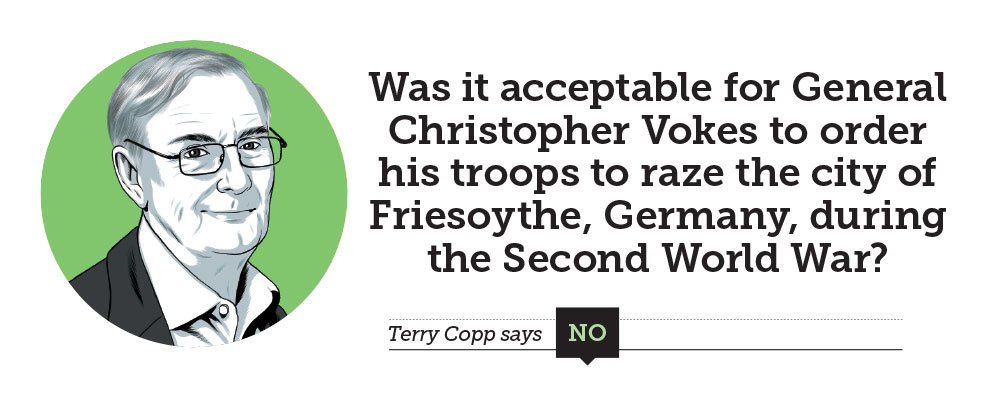
With hindsight, qualified by the modern moral temperament, the deliberate destruction by Canadian troops of much of Friesoythe on April 13-14, 1945, is indefensible. Ostensibly, Major-General Christopher Vokes’ exact orders were: “Burn the fucking town!”
The order arose from his understanding that Argyll and Sutherland Highlander commander Lieutenant-Colonel Frederick Wigle had been killed by a villager wearing civilian clothing. In fact, Wigle died after being struck in the chest by a burst from a Schmeisser machine gun during a pitched battle with German soldiers attempting to overrun the Argylls’ battle headquarters on Friesoythe’s outskirts.
Most Argylls, however, unquestioningly accepted the civilian sniper rumour that immediately swirled through their ranks, then up the command chain to 4th Armoured Brigade’s Brigadier Robert Moncel, and onward to Vokes. Although Wigle had commanded the Argylls only since February, his combat leadership had earned a Distinguished Service Order during the Rhineland battles and appointment as an Officer of the Order of the British Empire. He had the eye of the army’s high command for higher rank and was popular with the Argylls. His death, one Argylls officer wrote, left the battalion “shocked and grieved.”
It also generated a desire for revenge. “I was driving a flamethrower,” said Private Harold Reid, “and we burned the whole town down. Revenge, eh—’cause they killed our Colonel.” Elsewhere in Friesoythe, men stuffed rags into Jerry cans, set the wicks alight, and chucked the cans into the small, wood-framed houses. After impassively watching a church steeple collapse into the flaming structure below, Pte. Donald Stark walked into a house, climbed its stairs, and calmly threw a phosphorous grenade into each of three rooms. Flames were spreading when he strolled away.
As darkness fell, 4th Brigade’s war diarist wrote that “Friesoythe was a reasonable facsimile of Dante’s Inferno.” Higher up, what happened at Friesoythe went unmentioned in records and there was no following investigation. After the war, army historian Lt.-Col. C.P. Stacey confirmed Friesoythe’s burning through a personal visit. He called the incident “a mistaken reprisal” and could find no record of how the civilian sniper rumour “came about.”
“There is a definite hardening of the Canadian point of view,” wrote the 8th Light Anti-Aircraft war diarist in the immediate aftermath. “Civilians in Friesoythe are finding that treachery does not pay. The [Argylls] were attacked in that town yesterday by German forces assisted by civilians and today the whole town is being systematically razed. A stern atonement, but one which the Hun knows himself and understands. It seems folly now to continue to fight, but as long as fanatical Germans continue to accept [battle], the war will go on.”
These words cut to the chase. With the war rapidly drawing to a close, Canadians killed by perceived direct civilian action or collusion between civilians and soldiers invited brutal retribution. Friesoythe was the ultimate example of this. Unjustifiable today, but understandable when viewed through the lens of the time.


Historians have largely ignored operations carried out by the Allied armies in the last weeks of the war, although many battles were as complex as those west of the Rhine. Canadian actions in the Netherlands and Germany were brief, intense and bloody. Street fighting in Groningen, siege warfare at Delfzijl, the Küsten Canal crossing and the battle for Leer were especially difficult because the war seemed to be almost won. To Allied troops, the enemy were bloody-minded bastards ready to die for an evil cause or surrender two minutes after they had killed one of your comrades.
No one bothered to explain the necessity of continuous pressure, dictated by the need to reassure the Russians that we were not easing up and planning a separate truce with the German army.
Fourth Canadian (Armoured) Division, worn out by the battle for the Hochwald Gap in March, crossed the Rhine after the German retreat began. Their task, protecting the left flank of Second British Army, seemed low risk until the Twente Canal, where the Lincoln and Welland Regiment suffered 67 casualties before Delden was liberated. Crossing into Germany, the Argyll and Sutherland Highlanders of Canada cleared Meppen and began the advance to Oldenburg, the divisional objective.
Advancing on a single axis, which the engineers described as “the heart of a peat bog which permitted no deviation from a straight and narrow front,” the motorized Lake Superior Regiment captured Sögel on April 9. But as supporting units moved into the village, a German battle group including “very young men in no discernable military uniform,” counterattacked, forcing the men of 12 Canadian Light Field Ambulance to defend their advanced dressing station “with weapons borrowed from the patients.” Five medical personnel were wounded.
In the aftermath, divisional engineers used dynamite to destroy buildings in Sögel and used the rubble to build up the “sinking road” to Oldenburg.
After Sögel, even the youngest teenager was made to raise his hands and turn out his pockets before surrendering. At Friesoythe, the Argylls staged a typically well-managed attack to seize the town, but their headquarters group was attacked and three men, including their popular commanding officer, Lt.-Col. Frederick Wigle, were killed. A rumour circulated that Wigle had been sniped by a civilian and some Argyll soldiers began to retaliate, setting fire to several houses.
This incident could easily have been brought to an end by responsible leaders; instead Maj.-Gen. Chris Vokes, an officer promoted well above his capacities, ordered the razing of the town. More than two thirds of the 391 buildings in Friesoythe were destroyed or damaged, including the two churches. Vokes and those who carried out his orders dishonoured the army. They should have been called to account in 1945 and still should today.
MARK ZUEHLKE is a military historian and author of the 12-book Canadian Battle Series as well as The Canadian Military Atlas. He received the 2014 Governor General’s History Award for Popular Media: The Pierre Berton Award.
TERRY COPP is director emeritus of the Laurier Centre for Military and Strategic Disarmament Studies at Wilfrid Laurier University. He is the author of numerous books and articles on Canada’s role in the two world wars.
Advertisement
Related posts:
Face To Face: A century ago, Winston Churchill resigned from the British cabinet to serve on the Western Front. Was this the pivotal moment of his military and political career?
Face to face: Was Canada’s mission in Kandahar a success?
Face to Face | Should Newfoundland have joined Confederation?
Should Canada increase its military involvement in the Indo-Pacific region?












